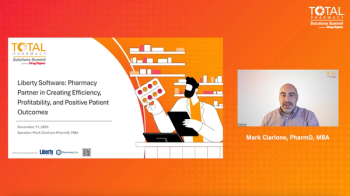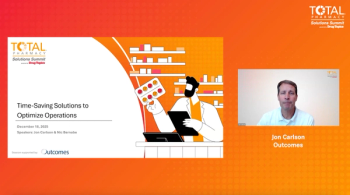
- Drug Topics October 2019
- Volume 163
- Issue 10
Solving the Drug Shortage Burden
Drug shortages might be decreasing, but their continued existence is urging the pharmacy industry to maintain its vigilance.
Although the number of new drug shortages in the United States has declined to 186 in 2018 since a high of 267 in 2011, there have been 80 for the first half of 2019, according to the University of Utah Drug Information service.
“Shortages continue to be on the rise and in talking with our customers, we’ve discovered the problem continues to get worse. More medications are going on allocation or unavailable and what used to be short, periodic shortages have become long and drawn out, making it a continuous challenge for clinical leaders,” says Patrick Yoder, PharmD, CEO, LogicStream Health, a Minneapolis-based clinical process improvement and control software provider.
“Some medication shortages have been going on for years with no real sign of recovery,” he says.
“While the number of drug shortages has declined substantially in recent years, any drug shortage places substantial burdens on healthcare, providers who may have to ration medicines or identify alternative treatments,” says Andrew Powaleny, director, public affairs for Pharmaceutical Research and Manufacturers of America (PhRMA).
Trending:
“The issue of drug shortages demands attention and collaboration from all stakeholders involved in providing life-saving medicines to patients. This includes the biopharmaceutical companies producing brand-name medications, as well as generic drug and biosimilar manufacturers, wholesalers, distributors, pharmacies, and healthcare providers,” he says.
A
Nearly two-thirds of respondents report they managed at least 20 shortages from July through December 2018; 64%, more than 21; 33%, six to 20; and 3%, up to five. Thirty- eight percent report one or more medication errors directly related to a drug shortage in that same time period.
The most commonly reported items facing shortages, according to the survey, are controlled substances, local anesthetics, antibiotics, electrolytes, and emergency injectables such as “crash cart” drugs, many of which are low-cost generics.
Read More:
Injectables comprise 39% of drug shortages in 2019, according to the University of Utah Drug Information Service.
Top causes of drug shortages
The FDA primarily attributes shortages to quality/manufacturing issues but also points to production delays, some caused by not receiving raw materials and components from suppliers, and drug discontinuations. An estimated 70% of shortages are caused by manufacturing and quality problems, according to the Healthcare Supply Chain Association.
“The FDA can’t require a firm to keep making a drug it wants to discontinue. Sometimes these older drugs are discontinued by companies in favor of newer, more profitable drugs,” says Charlie Kohler, spokesperson for the FDA. “With fewer firms making older, sterile injectable drugs, there is a limited number of production lines that can make these drugs. Raw material suppliers also are limited in the amount they can make due to capacity issues at their facilities.”
Kohler says that these limitations, along with long lead times and the complexity of the manufacturing process for injectable drugs, result in shortage vulnerabilities. “When one company has a problem or discontinues, it is difficult for remaining manufacturers to increase production quickly, and a shortage occurs,” he says.
Dan Kistner, PharmD, senior vice president, pharmacy solutions for Vizient, outlines the causes of drug shortages:
- Supply chain unavailability
- Lack of active pharmacy ingredients
- Natural disasters
- Too many lines offered, making it difficult to maintain capacity
- Regulatory issues
- Aggregate product quota preventing other manufacturers who might enter the space from making more product
- Low ROI. If a product is not profitable, manufacturers might switch to other drugs
- Consolidation
Powaleny attributes drug shortages to shifts in clinical practices; wholesaler and pharmacy inventory operations; changes in hospital and pharmacy contractual relationships with suppliers and wholesalers; and manufacturing issues, such as an unforeseen breakdown in manufacturing equipment that disrupts production.
Vaccinations:
“The difficulty is identifying what medications will be impacted by any of these things and how that will affect care delivery and patient safety, along with understanding when any particular shortage will occur,” Yoder says.
Shortages create repercussions
“The biggest risk is patient safety and potential harm to patients when clinicians cannot deliver appropriate care because of a medication shortage. Deferring procedures, adverse drug events, medication errors, cost of alternatives, and the time clinical teams spend managing shortages are all results of shortages,” Yoder says.
The Vizient survey focuses on the impact of drug shortages on U.S. hospital labor forces. Responses indicate that shortages are costing these institutions $359 million a year in labor expenses, or about 8.6 million hours of additional labor, to seek supply, update technology, and implement mitigation strategies that enable continuity of care. Survey participants attributed labor costs to triaging patients and making changes in the ordering system.
The repercussions of drug shortages not only impinge on financial resources but also on patient care, from delay or cancellation of a medication or treatment to medication errors. The Institute for Safe Medication Practices conducted a survey primarily of hospital-based pharmacy directors and managers, purchasing agents, and technicians from August through October 2017. It found that the majority (71%) were unable to provide patients with a recommended drug or treatment, and 47% thought this resulted in patients receiving a less effective drug. In addition, 75% stated that patient treatments had been delayed because of drug shortages.
Solving the drug shortage problem
Kistner recommends some strategies for mitigating drug shortages: increase competition; ramp up supply and capacity; reward quality in generics; expedite manufacturer approval processes; provide real-time analytics about what is purchased and which supplies are dwindling; and apprise hospitals of potential drug shortages so that they do not become a repeat problem.
Autoimmune:
Among Vizient’s solutions are Novaplus, which provides access to 15,000 individual, high-demand line items encompassing a broad range of categories.
Respondents to the Vizient survey had a say in what they believe to be effective solutions to the drug shortage problem: implementing processes to restrict duration of therapy; increasing stock of medications that were anticipated to be limited in supply; utilizing unit dosing to prevent waste; using alternative ways of administering a drug; and implementing one or more taskforces or committees dedicated to addressing drug shortages and allocations.
LogicStream has introduced the Drug Shortage App that identifies shortages and their impact on hospitals and automates the entire life cycle of managing a shortage. It provides clinical information that allows teams to understand and mitigate the ramifications for shorted medications. Yoder says that although most hospitals have a drug shortage management process, they tend to be manual, time-consuming, and costly.
FDA tackles drug shortages
“FDA responds to potential drug shortages by taking actions to address their underlying causes and to enhance product availability. It determines how best to address each shortage situation based on its cause and public health risk,” Kohler says.
Read More:
To address manufacturing/quality problems, FDA works with manufacturers to resolve issues, from an incorrect expiration date on a package to finding a particulate in a product. “Regulatory discretion may be employed to address shortages to mitigate any significant risk to patients,” he says.
The agency also assists manufacturers with drug shortages in ramping up production if they are willing to do so. Kohler says this often necessitates approval of new production lines and raw material sources to help increase supplies. FDA expedites review of these to help resolve shortages of medically necessary drugs; however, the agency can’t require companies to increase production.
If a manufacturer has data to support extension of an expiration date for inventory that is close to expiration or has already expired, FDA is able to review this information and approve the extension, helping to increase supplies until new production is available.
In addition, FDA could turn to other manufacturers that are willing and able to redirect product to the U.S. market if a shortage involves critical drugs needed for U.S. patients. This requires an evaluation of a product to ensure efficacy and safety, including the formulation and other attributes of a drug and the quality of the manufacturing site where a drug is made.
Kohler says that while the FDA looks for ways to mitigate drug shortages, there are a number of factors that can cause or contribute to the problem that are outside of the FDA’s control.
The agency issued a long-term, strategic plan to outline its priority actions and efforts drug manufacturers and others can take to prevent drug shortages by promoting and sustaining quality manufacturing, along with launching the Drug Shortages Task Force July 2018, to study reasons why shortages continue.
Articles in this issue
about 6 years ago
The Truth About Statinsabout 6 years ago
Opinion: Color Coded Inhalersabout 6 years ago
Pharmacist Collaborations Must Extend to Dentistsabout 6 years ago
Contemplating the Future of List Pricesabout 6 years ago
New Drug Review: Tafamidis Meglumine for Cardiomyopathyabout 6 years ago
Life-Altering Gene Therapy Pipeline Poses Challengesabout 6 years ago
Providing Healthcare to Transgender Patientsabout 6 years ago
State Laws May Determine Access to Pharmacy-based PrEP Clinicsabout 6 years ago
Official CVS/Aetna Merger: Greater Convenience, Less Cost Reformabout 6 years ago
Alternative Approaches to OpioidsNewsletter
Pharmacy practice is always changing. Stay ahead of the curve with the Drug Topics newsletter and get the latest drug information, industry trends, and patient care tips.











































































































































































































